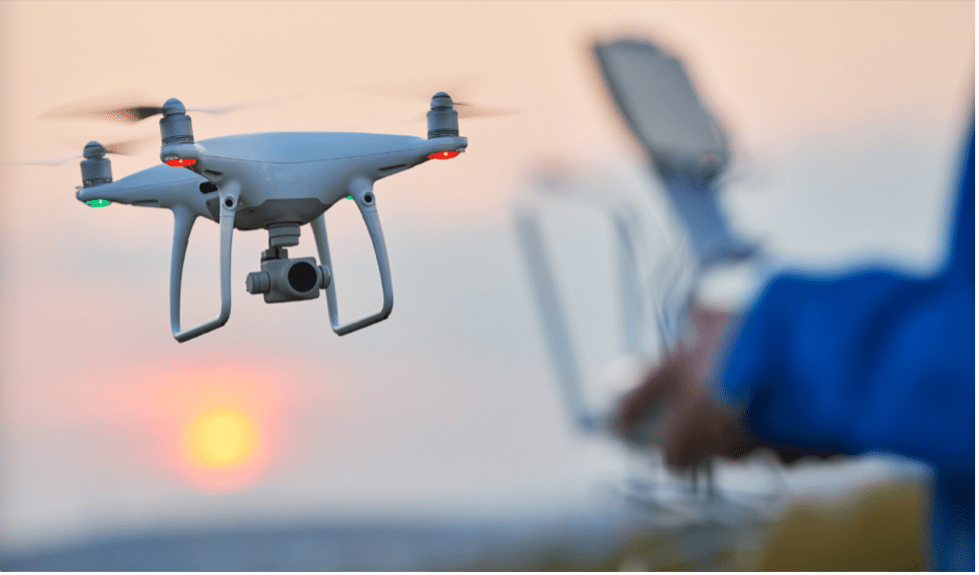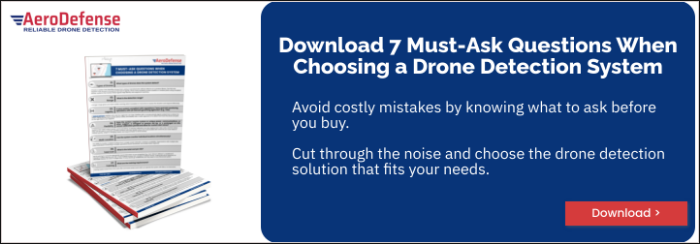Summary: Detecting drones legally means using RF tech like Remote ID. Learn how to track drones and pilots with AeroDefense’s trusted AirWarden system.

Not everyone is an engineer or drone technology expert, and that’s okay. If you’re tasked with protecting your facility, understanding the basics of detecting drones is critical.
This FAQ guide breaks down common questions related to drone detection technologies and legal considerations.
FAQs About Detecting Drones
When detecting drones, what’s the difference between RF and radar drone detection?
Radio Frequency (RF) Detection: Identifies and tracks drones by detecting the radio signals they emit during flight. Most drones communicate using RF signals to stay connected with their remote controllers. Some also transmit signals using Bluetooth or Wi-Fi.
A key component of modern drone detection is the ability to detect Remote ID signals. Remote ID is a regulation from the Federal Aviation Administration (FAA) that requires most drones flying in U.S. airspace to broadcast identifying information. This includes the drone’s serial number, current location, altitude, speed, and — in many cases — the location of the pilot or takeoff point. These broadcasts occur over standard RF bands such as Bluetooth and Wi-Fi.
Radar Detection: Emits RF pulses and detects reflected signals from moving objects like drones. Requires line of sight and is more prone to false positives (e.g., birds).
When detecting drones, how can a drone be traced to its pilot?
Radio frequency-based drone detection is the only technology that can reliably locate the pilot—often the safest and most actionable form of mitigation.
Remote ID Detection
What it is: FAA-mandated system requiring drones to broadcast identifying data over radio frequency.
How Remote ID helps:
Remote ID broadcasts typically include the location of the drone and the location of the pilot or takeoff point.
Remote ID receivers can passively collect this data in real time, allowing teams to view both the drone’s position and the pilot’s location.
RF Signal Detection or RF Spectrum Sensing
What it is: Systems that scan for radio frequency signals between the drone and its controller, typically in the 2.4 GHz and 5.8 GHz bands.
How it helps:
Some RF detection systems use trilateration, which relies on signal timing and/or strength, to estimate the pilot’s location—depending on sensor placement and system synchronization. Others use triangulation, analyzing the direction of the drone’s and controller’s signals. Either method is effective even for drones that do not broadcast Remote ID.
However, it's important to note that some systems attempt to decode or demodulate the drone’s control signal, which can violate U.S. federal law if done without proper authorization, as it may involve intercepting private communications.
Only RF Technologies Can Directly Provide Pilot Location
Other detection technologies like radar, optical, or acoustic systems can locate the drone, but not the pilot — unless paired with RF-based capabilities such as Remote ID detection or RF signal detection.
When detecting drones, what are the most effective anti-drone technologies?
This depends upon your use case and risk profile. When evaluating a drone detection system, it’s important to match your solution to the level of risk you face.
Most drone incidents involve hobbyists flying FAA-compliant drones that broadcast Remote ID. Detecting drones with a system like our AirWarden Essentials® provides a cost-effective way to monitor typical drone activity and gauge your overall exposure.
If you begin seeing drones that aren't broadcasting Remote ID, this may indicate a more serious threat. In those cases, AirWarden Spectrum offers a more advanced solution designed to detect non-compliant or modified drones.
When detecting drones, what laws govern drone detection?
Federal laws like the Pen/Trap Statute and Wiretap Act prohibit interception or decoding of signal content without a warrant. Legal RF detection systems avoid demodulation and decoding.
Detecting drones with Remote ID is an easily accessible way to detect drones (as long as you have the infrastructure in place to receive the signals) and complies with the most up-to-date federal advisory on drone detection and mitigation as of the date this article was published.
The recent EO Restoring American Airspace Sovereignty aims to address the growing threat of unauthorized drone activity. The EO focuses on countering malicious and unauthorized drone use by strengthening enforcement, improving detection capabilities, and protecting high-risk areas. It also establishes a federal task force to review and propose solutions to unmanned aircraft systems (UAS) threats.
The Pen/Trap Statute and Wiretap Act don't apply to our solutions because of the detection and location methods that we use.
When detecting drones, can I take down a drone?
According to Federal Law, no. Drones are considered aircraft under FAA rules. Taking one down is illegal and may result in liability for damages or injuries. However, states such as Louisiana are implementing their own rules which you should be aware of.
When detecting drones - why should I care about drones if I’m not a high-profile target?
Even if you're not a high-profile target, drones can still disrupt your operations in unexpected ways. A single drone has delayed NFL games, shut down airports, and forced fire crews to ground aircraft. And in many cases, the operators weren't acting maliciously—they were just unaware or careless.
Not every drone is a problem, but without visibility into your airspace, you can’t tell the difference. Is it a permitted flight? A hobbyist making an honest mistake? A drone in my own fleet flown by a team member? Or someone collecting footage without permission?
Airspace awareness gives you the context you need to respond appropriately—avoiding confusion, unnecessary escalation, and potential legal or operational fallout.
When detecting drones - is a layered detection system necessary?
It depends on your needs. For most common drones that broadcast Remote ID signals, RF detection alone is effective and reliable. It provides real-time identification of drones and their pilots without extra complexity.
While radar or visual systems can detect non-RF drones (radio-silent drones), these are rare and often less relevant for typical operations. If your primary goal is efficient, legal, and cost-effective drone awareness, a Remote ID–based RF solution is usually sufficient.
When detecting drones, should I wait for mitigation laws to change before buying detection?
No - waiting could leave you blind to what’s already happening in your airspace.
You don’t need to wait for mitigation laws to change to take action. Detection systems that locate the drone pilot are fully legal and provide the most practical path to resolution today. In fact, identifying the pilot often enables the safest, most effective way to stop unwanted drone activity—without ever needing to interfere with the drone itself.
Awareness is actionable. Waiting isn’t.
AeroDefense FAQs
How long has AeroDefense been in business?
Since 2015, with the first AirWarden deployment in 2017.
What are AeroDefense Drone Detection Solutions?
AeroDefense currently offers 2 drone detection solutions, AirWarden Essentials and AirWarden Spectrum. Both integrate with other detection technologies, such as cameras, radar, and acoustic drone detection.
AirWarden Essentials utilizes Remote ID to locate both the drone and the pilot. For many drone detection use cases, this solution provides an easy and cost-effective way to gain real-time airspace awareness and respond confidently to drone activity.
For more critical applications, AirWarden Spectrum is for businesses and government agencies that suspect or are aware of threats from highly sophisticated drone pilots with nefarious intent. A solution that detects both FAA Remote ID-compliant and non-compliant drones may be needed.
AeroDefense deploys radio frequency-based drone detection solutions for permanent or temporary use.
Are AeroDefense Drone Detection Solutions legal?
Yes. Our solutions use two primary, fully legal detection methods: passive Remote ID signal reception and spectrum sensing. The Remote ID capability receives publicly broadcast signals that drones transmit as required by FAA regulations. Spectrum sensing passively detects RF emissions without intercepting or decoding communications. Both methods comply with U.S. laws, making AirWarden a safe and reliable drone detection solution.
How are AeroDefense solutions different from competitors?
Legal, Actionable Detection You Can Deploy Today
Many competitors operate in legal gray areas or focus solely on mitigation. AeroDefense focuses on legally deployable detection—providing real-time location of both drone and pilot using signals like Remote ID and other RF emissions. This makes the system immediately usable by law enforcement and security teams without waiting for laws to change.
Remote ID and Beyond
AeroDefense offers detection based on Remote ID, which is now required for most drones and is sufficient for the vast majority of use cases. It provides affordable, actionable airspace awareness for organizations of all sizes. For highly sensitive or high-risk environments—where highly skilled malicious operators are a concern—we also offer solutions that detect non-Remote ID-compliant drones. Our solutions also integrate with other detection layers as noted above.
Affordable and Flexible Deployment
Unlike many systems that start at six figures, AeroDefense offers scalable solutions starting under $5,000/year. Whether you're securing a single event or protecting critical infrastructure, you can deploy the system permanently or temporarily—without special infrastructure or integration.
Tested and Trusted in Real-World Environments
Our solutions aren’t just lab-tested—they’ve been used at stadiums, correctional facilities, major events, and by public safety teams since 2017.
Built in the USA
All AeroDefense solutions are designed, built, and supported in the United States. This supports procurement requirements for many government and public safety agencies and ensures fast, knowledgeable support from a U.S.-based team.
What’s the range of AirWarden?
The detection range varies depending on the AirWarden solution you choose. AirWarden Essentials provides coverage of 100 square kilometers or more, offering broad and reliable Remote ID detection ideal for many use cases. AirWarden Spectrum's range depends on the number of sensors deployed. For detailed information tailored to your requirements, we recommend you download our spec sheets.
Because AirWarden holds a Direct to Phase II Small Business Innovation Research (SBIR) contract, federal agencies can bypass the traditional RFP and competitive bidding process when purchasing the system. SBIR guidelines allow agencies to issue sole-source Phase III awards to the original SBIR awardee for commercialization and deployment. This authority streamlines procurement and speeds up delivery for federal buyers.
If you’re new to the business of detecting drones, you’ll find our blogs and resources to be loaded with helpful information. As we noted above, feel free to reach out to talk with an expert!
You can also learn more by reading our Ultimate Guide to Drone Detection.


